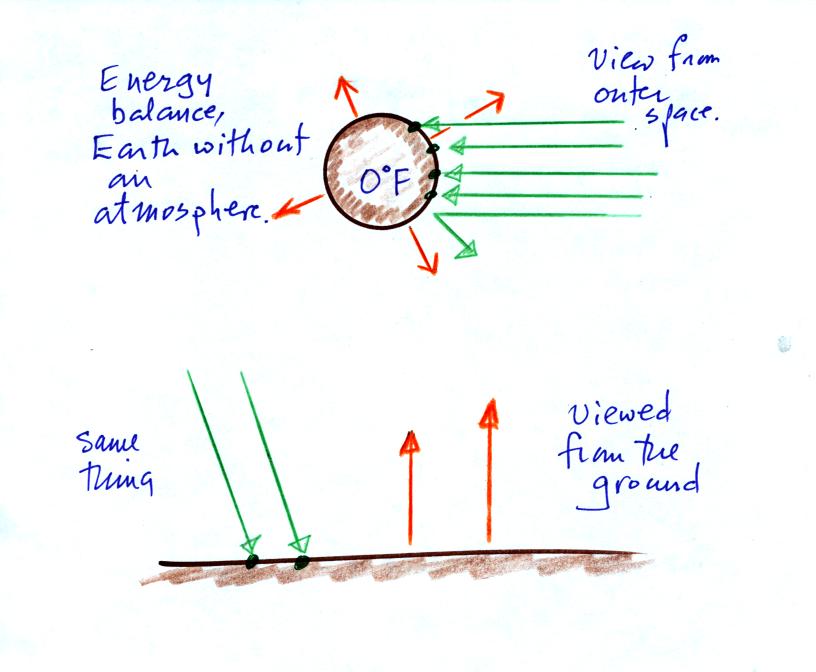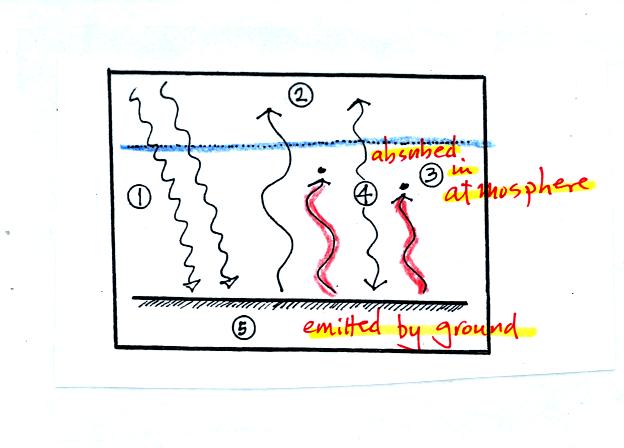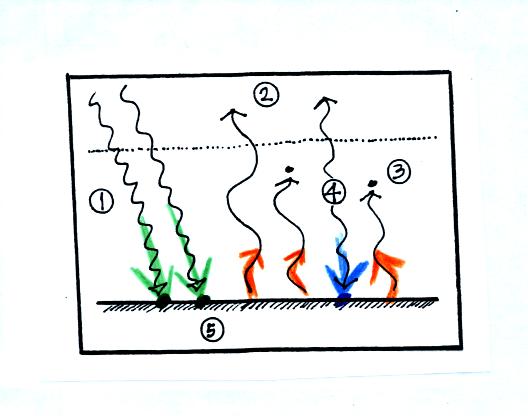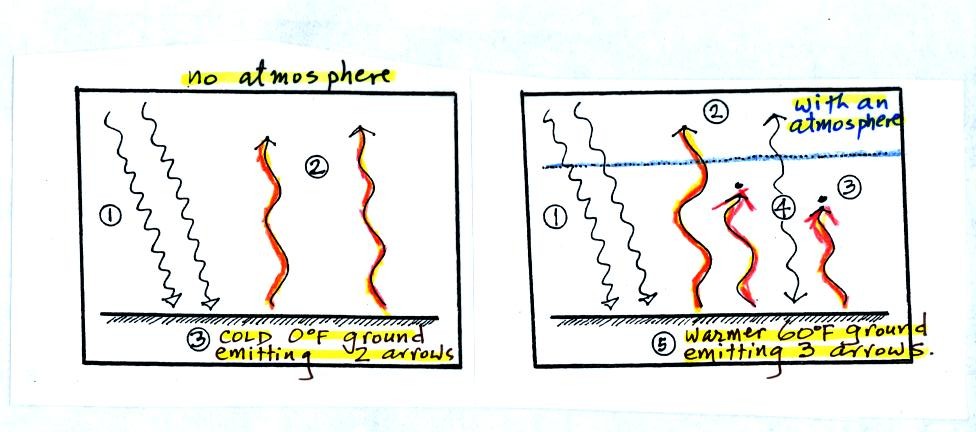Wednesday Oct. 3, 2007
Quiz #2 is next week (Wed., Oct. 10). A preliminary online
version of the Quiz #2 Study Guide is now
available. Reviews will be held Monday and Tuesday next week (the
Wednesday afternoon review is for the T Th section of the class).
Optional Assignment #2 will be returned on Friday. Answers will
appear online sometime in the next day or so.
Optional Assignment #3 will be due at the beginning of class next
Monday.
We
will be studying energy balance on the earth with an atmosphere
today. The greenhouse effect is a big part of this and we should
learn more about how that works today. First we will quickly
review what we covered last Monday.

The top figure shows energy balance on the earth viewed from a
vantage point in outer space. Five rays of sunlight arrive at the
earth. Four rays are absorbed, one is reflected. The
reflected ray doesn't really play a role in energy balance, it's as if
that ray wasn't even there. To be in energy balance the earth
must emit 4 rays of energy.
The lower figure above (see p. 70a in the photocopied Class Notes)
shows energy balance viewed from the ground. Two rays of incoming
sunlight are balanced by 2 rays of emitted radiation. The
temperature of radiative equilibrium (temperature of the earth's
surface) is about 0 F for this case. There's nothing special
about the fact that two rays are drawn, it could have been 3 or
4. The important detail is that absorbed energy is balanced by an
equal amount of emitted energy.
Today we will be adding an atmosphere to the lower figure above.
We need to know how the atmosphere will affect the incoming sunlight
and also the radiation emitted by the earth. This is something we
covered at the end of class on Monday.
We learned that the atmosphere is (1) largely transparent to visible
light, (2) pretty nearly opaque to UV light, and (3) selectively
absorbs IR light. It is this last property that will be most
important to us. It is the greenhouse gases in the atmosphere
that make it a selective absorber of IR light.
Now we
will look at a very simplified explanation of the greenhouse
effect. You'll find it on p. 70b in the photocopied Class Notes
(you might keep p. 70a nearby for comparison). We will examine
this figure one little part at a time.

The figure shows two rays of incoming sunlight that
pass through the atmosphere, reach the ground, and are absorbed.
100% of the incoming sunlight is transmitted by the atmosphere (this is
not a very realistic assumption).
The ground is emitting 3 rays of IR radiation.

One of these is emitted by the ground at a wavelength that is
NOT absorbed by greenhouse gases in the atmosphere. This
radiation passes through the atmosphere and goes out into space.

The other 2 units of IR radiation emitted by the ground are
absorbed by
greenhouse gases is the atmosphere.

The atmosphere is absorbing
2 units of radiation.
In order to be in radiative equilibrium,the atmosphere must also emit 2
units of radiation. 1
unit of IR radiation is sent upward into space, 1 unit is sent downward
to the ground where it is absorbed.

The greenhouse effect is found in this absorption and emission
of IR radiation by the atmosphere. We tried to put into words
what is illustrated above:

Before we go any further we will check to be sure that every part
of this picture is in energy balance.

The ground is absorbing 3 units of energy and emitting
3
units of energy

The atmosphere is absorbing 2 units of energy and emitting 2
units of
energy

2 units of energy arrive at the earth from outer space, 2 units
of
energy leave the earth and head back out into space.
Here's the first of this semester's hidden
optional assignments.
The
greenhouse effect makes the earth's surface warmer than it would be
otherwise.

Energy balance with (right) and without (left) the
greenhouse
effect. At left the ground is emitting 2 units of energy, at
right the ground is emitting 3 units. Remember that the amount of
energy emitted by something depends on temperature. Warm ground
will emit more energy than colder ground.

Here's another explanation. At left the ground
is getting 2 units of energy. At right it is getting three, the
extra one is coming from the atmosphere. Doesn't it make sense
that ground that absorbs 3 units of energy will be warmer than ground
that is only absorbing 2.
Next
we will look at how realistic our simplifying assumptions are.

In our simplified version of the greenhouse
effect we
assumed that
100%
of the sunlight arriving at the top of the atmosphere passes through
the atmosphere and gets absorbed by the ground. The bottom figure
above shows that in reality only about 50% of the incoming sunlight
gets absorbed at the ground.
About 20% of the incoming sunlight is absorbed by gases in the
atmosphere. Sunlight is a
mixture of UV, VIS, and IR light.
Ozone and oxygen will absorb a lot of the UV (though there isn't much
UV in sunlight) and greenhouse gases will absorb some of the IR
radiation in sunlight (IR light accounts for about half of the light in
sunlight).
The remaining 30% of the incoming sunlight is reflected back into space
(by the ground, clouds, even air molecules).
At the top of the figure below we see our simplified explanation of the
greenhouse effect. You should be able to exlain what each of these
arrows represents.

The lower part of the figure is pretty complicated. It would be
difficult to start with this figure and find the greenhouse effect in
it. However if you understand the upper figure, you should be
able to find and understand the corresponding part in the lower figure.
We
will check the various parts of the complex figure to be sure they are
in energy balance. In doing this, a small piece at a time, you
should recognize and understand what is being illustrated. We
will start with the atmosphere.

The atmosphere is emitting 160 units of energy. 64 units
go up and into space, 96 units go down and are absorbed by the
ground. How would you explain the difference between the amounts
being emitted upward and downward. One explanation might be
temperature. The upper atmosphere might be colder than the lower
atmosphere. Colder air would emit less EM radiation than warm
air. The upper atmosphere air density is lower than the lower
atmosphere air density. This might also explain the difference.

19 units of sunlight energy are being absorbed by the
atmosphere. 111 units of IR radiation emitted by the ground are
absorbed by the atmosphere. The 23 units at left is energy
transported in the form of latent heat (water in the lake evaporates,
heat is released into the atmosphere when the water vapor condenses and
forms the cloud). Together conduction and convection transport 7
units of energy from the ground to the atmosphere.
Next
energy loss and gain at the ground

The ground is absorbing 147 units of energy. Surprisingly
the ground gets almost twice as much energy (96 units) from the
atmosphere as it gets from the sun (51 units). This is partly due
to the fact that the sun is shining on any particular area for part of
the day while the atmosphere is emitting IR radiation downward toward
the ground all the time.

The ground is losing 147 units of energy, so everything is in
balance at the ground.
Next we'll
check energy arriving at the top of the atmosphere from space and
energy leaving the atmosphere and going back out into space.

The earth and atmosphere send 70 units out into space. This
is balanced by 70 units of sunlight arriving at the earth shown in the
figure below.

On Friday, we'll use our simple explanation of the greenhouse effect to
try to understand how clouds affect daytime high and nighttime low
temperatures. We also see how enhancement of the greenhouse
effect could cause global warming.



















